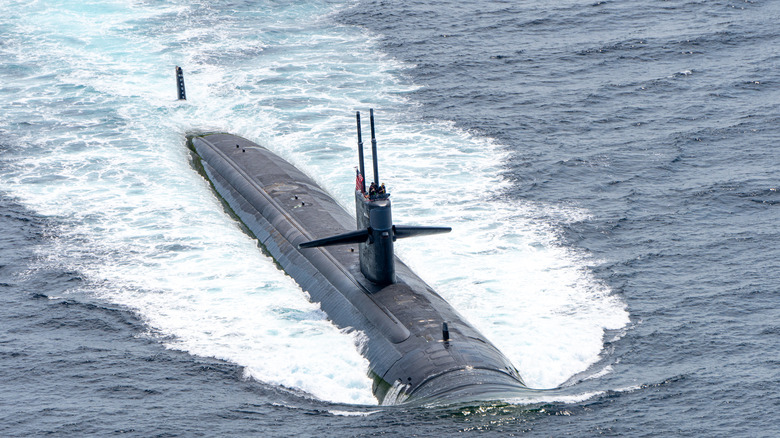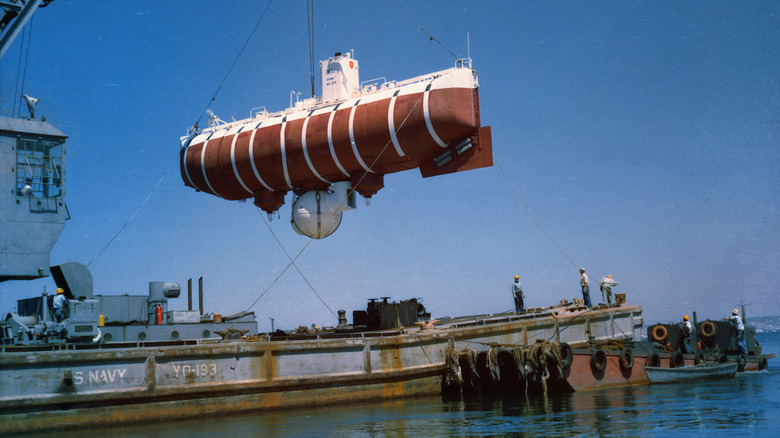Submarine Vs Submersible: The Big Difference, And Why It Matters
With the search for OceanGate's Titan submersible, it bears asking the question: how is a submersible different than a submarine, and what sets the Titan apart from your average sub? For starters, the terms "submersible" and "submarine" are not synonyms, and while both describe the same basic thing — an object that goes underwater — the two vehicles operate very differently.
According to Dr. Edith Widder, a scientist with the Harbor Branch Oceanographic Institution, a submersible is not a self-sufficient vessel; it has limited resources onboard to keep it underwater and the crew alive, plus it needs a support craft to launch and be recovered. A submarine, on the other hand, can accomplish that task by itself. There are no size, speed, depth, or crew size qualifications. If it has a "mothership," it's a submersible. If it can go in and out of port, it's a submarine. OceanGate's Titan was launched from a larger ship, the Polar Prince, which makes it a submersible.
Titan wasn't an ordinary submersible
Why does the difference between a submersible and a submarine matter? Because, put simply, a submersible is dependent upon its launch ship to resurface — otherwise, it must rely on the eventual loss of attached weights (which detach due to eventual erosion) to bob to the surface. That uncontrolled rise to the top would be risky for the crew on board and could make it difficult for those on the surface to locate the vehicle. A submarine, on the other hand, is able to surface under its own power, meaning it is not dependent on a launch ship.
With that said, Titan was no ordinary submersible — and not in a good way. OceanGate Expeditions, the company behind the vehicle, didn't get its submersible certified or classed. No regulatory authority evaluated the vehicle for safety, something CEO Stockton Rush — who was on the Titan when it went missing — said wasn't that big of a deal, arguing that the classification process would simply stifle innovation. The submersible featured some questionable design choices, including one-button operation with only touch screens and an old game controller maneuvering.
Is a submarine better than a submersible?
For submarines, the United States Navy operates a number of different varieties that serve different purposes. But when you picture a quiet, ominous nuclear-powered undersea metal tube that can unleash nuclear hellfire anywhere in the world at a moment's notice, you are likely picturing a Los Angeles-class submarine made by General Dynamics Electric Boat during the Cold War. Exact specifications are still classified, but it can reportedly dive to depths of over 800 feet, has a crew of 16 officers and up to 127 sailors, and can reach speeds of over 25 knots (28 mph) at full tilt. Throw in the ability to launch Tomahawk missiles, a nuclear reactor for power, and the ability to stay underwater for months at a time, and you have what forms a large portion of the U.S. Navy's underwater fleet.
A submarine may have the horsepower and resources onboard to stay under the waves much longer than a submersible, but one vehicle isn't any "better" than the other. In 1960, the Swiss and American bathyscaphe Trieste submersible, crewed by U.S. Navy Lieutenant Don Walsh and Jacques Piccard, was the first-ever manned vessel to reach Challenger Deep, a part of the Mariana Trench that's seven miles underwater, and the deepest known part of the ocean. It was also responsible for finding the remains of the U.S. Navy's missing nuclear submarine the USS Thresher in 1963.


